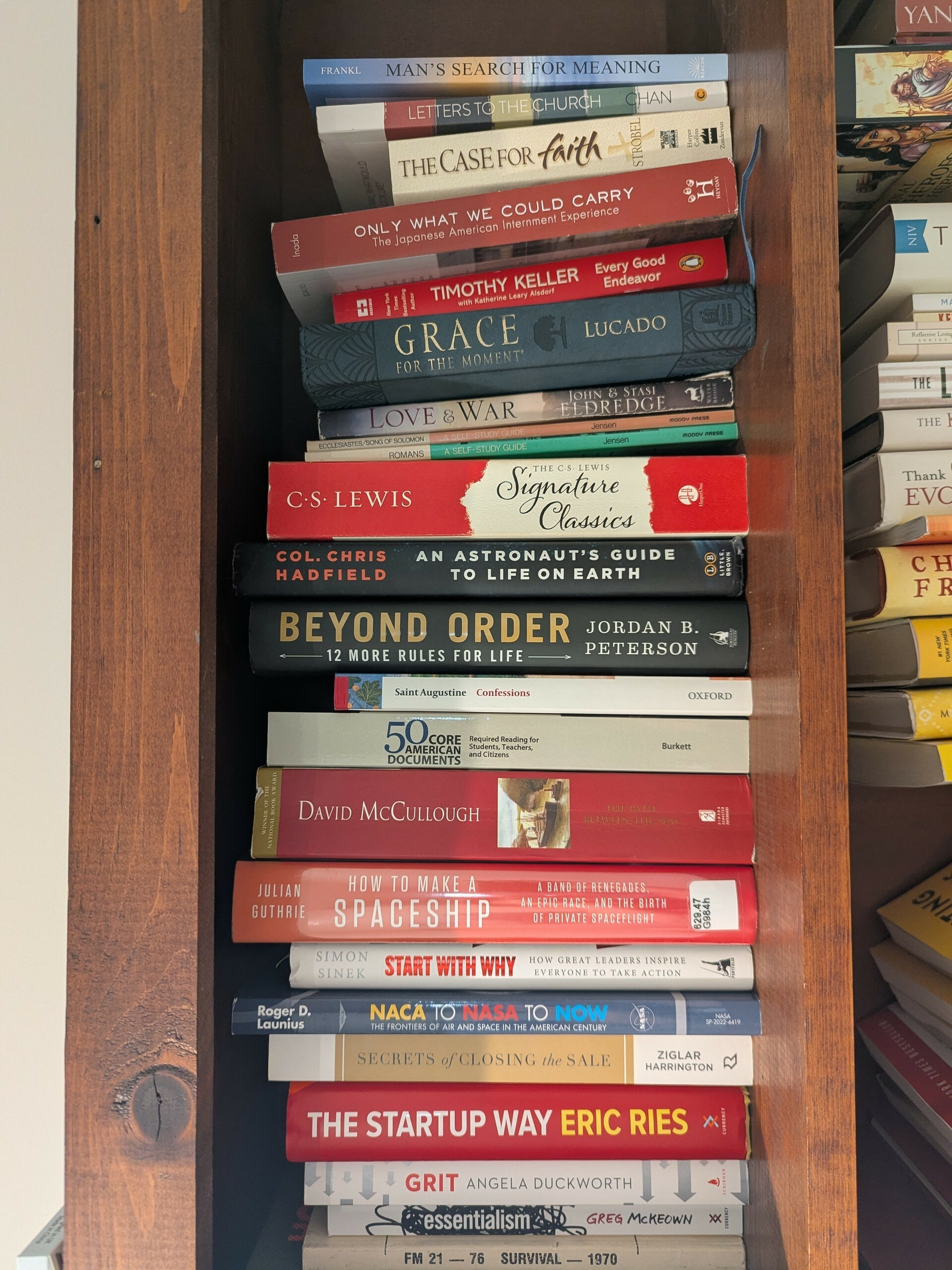obsidian
- Most popular: My Obsidian Daily Note Template - this is consistently my most-viewed article. It was my first article of the year, and is a technical deep dive into how I set up my daily notes in my note-taking app. I still get an email roughly monthly from someone asking me further questions about how I set things up in Obsidian. Actually, as I was writing this, someone reached out from the article and asked me if I have implemented “heat map habit tracking” in Obsidian (I have not). This article had 243 views in the last 90 days. For reference, the next most viewed article over that span had 17 views.
- Most words: My Obsidian Daily Note Template - ~3500 words. The runner-up is my recent post on Aqua Notes at ~1800 words.
- Least words: This Started With A Title - 23 words
- Personal Favorite: Street Corner - Although my technical explainer posts seem to get more views, I love writing personal reflections. This one felt really raw. I remember experiencing the moment I describe in the article, and then feeling later that day like I just had to write about it.
- Average time spent writing each article: No idea. I don’t track this. But it’s pretty short I think. Maybe an hour or two? I don’t usually spend multiple days with a lot of editing and researching and refining. I write it and send it.
- habits
- daily log
- tasks
- journaling
- Specify a template folder (I use “Bins/Templates”)
- Trigger Templater on new file creation. You want this on so that Templater works with Daily Notes and Periodic Notes.
- overdue
- due today
- coming soon (next 3 days)
- completed today
- Templater
- Templater
- Templater
- Format - sets the format for the date
- Offset - I keep this at 0 because I want the current date. 1 would give me tomorrow, -1 would give me yesterday.
- Reference - the date to use. If not provided, the function uses today’s date when a note is created from it. I supply the file title here so that no matter when I make my daily note, the title in the note matches the file title. For example, I might create tomorrow’s daily note ahead of time to start taking notes for tomorrow, so I want the file title to be the date used, NOT today’s date during note creation.
- Reference format - the date format for #3
- Templater
- Use
tp.file.titleto get the date, offset -1 for yesterday - Use
tp.file.titleto get the date, offset +1 for tomorrow - Use
tp.file.titleto get the date, format to my weekly note title format - Use
tp.file.titleto get the date, format to my monthly note title format - QuickAdd
- Buttons
- I use Obsidian mobile, and often view notes in reading mode from my phone. Having the button allows me to quickly capture a log even from reading mode
- I like having a timestamp for my log entries. It forces a chronological log I can look back on.
- Templater
- Tasks
- it looks to see, “Does this task have a tag with an area section?”
- if it does, it cuts off the project from the end, and returns the area like:
#{prefix}/{area} - if it does not, it returns empty
- Personal
- Work
- Uncategorized
- N/A
- Dataview
- Templater
- were created on or after today at 12AM
- were created on or before tomorrow at 12AM
- except for this daily note
- were modified on or after today at 12AM
- were modified on or before tomorrow at 12AM
- except for this daily note
Sharing all of my book, article, and podcast highlights
I finally got my Readwise Highlights synced into Obsidian in a way that lets me share all my highlights from my digital garden (garden.weidok.al). Take a peek if you want to see the books, articles, and podcasts I’ve highlighted and taken notes on:
Jakes Digital Garden - 400 Readwise Highlights
As I mentioned earlier this week, I’ve been reading a lot more physical books and I haven’t made the effort to save my highlights from those into Readwise. I probably never will, because that’s a ton of manual work. If you’re interested in the books I’m reading, send me a friend request on Goodreads!
And as always, reach out if you see anything that piques your interest!
2024 Blog in Review

My first full year of blogging is in the books! Or should I say, in the internet archive? Check out this neat sitemap graph of my blog generated by the internet archive.
I can’t believe I’ve been doing this for over a year!
One thing that has become clear is I write more like a geyser than a waterfall. I spend most of my time dormant, and then have a sudden flurry of activity before going quiet again. In the new year I would like to move a little more toward the waterfall model: steady, consistent, and reliable. But, I also would like to have more grace for my geyser-like tendencies. The geyser is beautiful in its own way.
Articles
This year I wrote 34 articles. Well, 35 if you include this one.
My unspoken goal before the year was one article a week, but I’m happy with where I landed. I liked not feeling pressured and being able to write when inspiration struck. That said, I’ve been toying with the idea of committing to writing something on a weekly cadence. I’ve thought about starting a separate newsletter, but that’s more than I want to take on right now. Instead, I’m thinking about doing a weekly review post on this blog instead. That will force me to reflect on my life more regularly, and will keep my 8 email subscribers up-to-date with my weekly happenings.
Here are some stats on those 34 articles:
Microblogs
I also posted 132 microblogs this year. A large chunk of those were in January, because I went through the book of Proverbs and did a post for each one trying to summarize the most salient points in my own words. This was my way of “starting my year with wisdom” and was also meant to get me into the habit of regularly posting to my blog, no matter how uncomfortable it felt at the time.
Traffic
I didn’t start tracking analytics until later in the year, but since September 432 people have visited my blog.
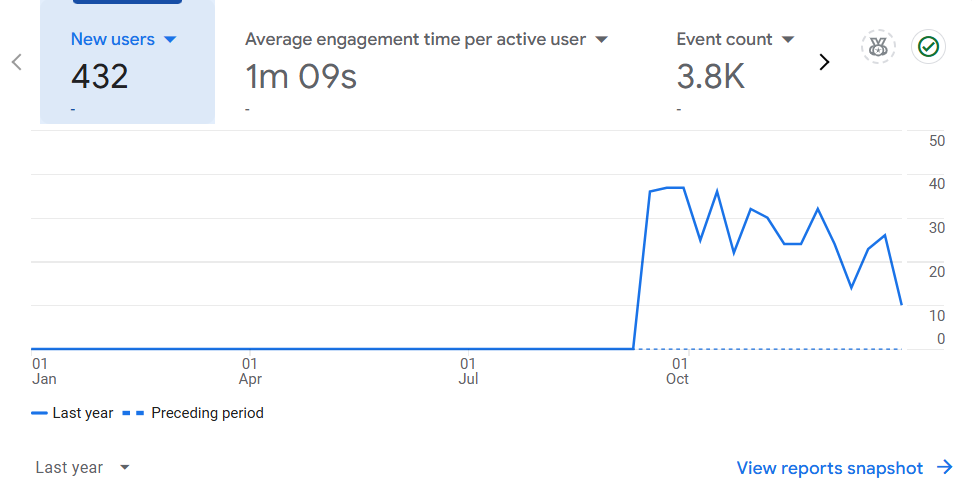
About 62 of those users came back to my site at least once, and on average people spend 1 minute and 9 seconds on the blog.
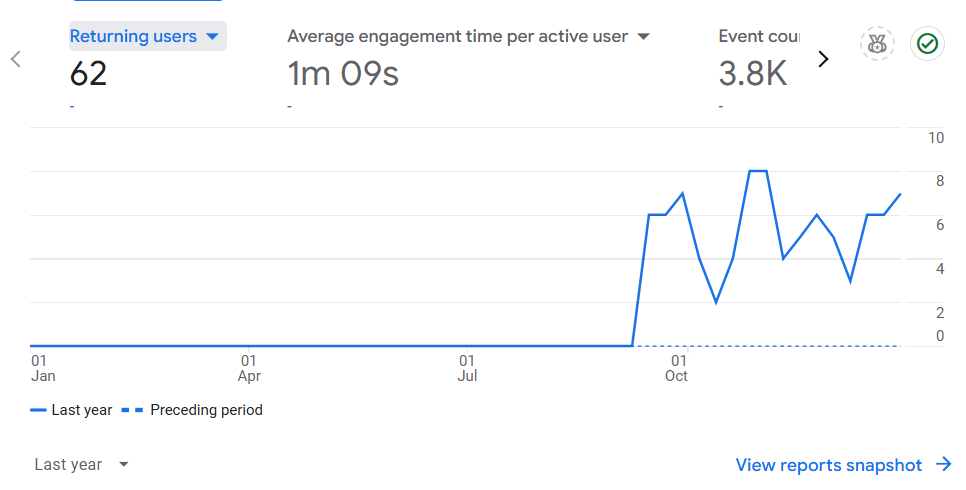
The blog was a global sensation (hyperbole) with visitors from every continent other than Antarctica (shout out to the one visitor from Egypt representing all of Africa).

People came to my blog from various corners of the interwebs. Direct traffic, LinkedIn, Google, Reddit, and my newsletter service were all big drivers.

Most people visiting my blog were probably using Chrome on a Windows machine.

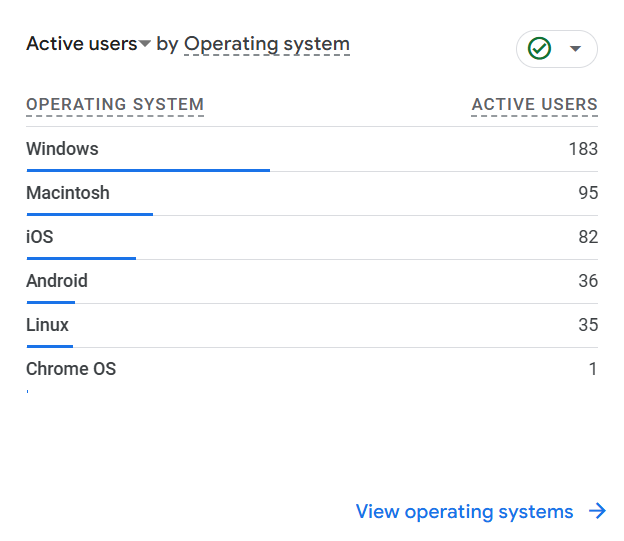
So, what is my takeaway from all of these analytics? Not much. It’s fun to look at during the end of the year, but there’s nothing actionable for me here. I’m not trying to supercharge my blog’s growth. I just want to write meaningful and helpful words.
Design
I made various changes to the look and feel of my blog throughout the year. You can see all the changes I made since June 10, 2024 in my changelog. It looks very different from where it originally started, which I shared screenshots of in Tear it All Down.
I’m following the KISS design principle: “Keep It Simple Stupid”.
What will 2025 hold?
Your guess is as good as mine. Will I become an author? Will I abandon my blog and run off with my pen and analog journal? Will artificial intelligence and quantum computing and brain chip implants converge to make the written word irrelevant as we all mind meld and communicate wordlessly and instantly? All possibilities.
As far as my blog goes, 2025 will be similar to 2024. I want to write more, and I’m sure I’ll make design tweaks to my blog here and there. But otherwise I’ll continue to write things that I think are meaningful and/or helpful.
As far as my life goes, it looks like change is a brewin'. I’m looking forward to the new year and all that it has to offer. Some things are scary, some are exciting, all will make for good writing material.
I can’t wait to share my perspective in the new year with you. Thanks for sticking around through my self-indulgent “blog in review” post.
I wish you a happy new year and hope your year is filled with love, given and received.
I shared my article about my Obsidian Daily Note template on Reddit in the ObsidianMD community and got a really positive response. I was surprised how quickly people were already trying to incorporate changes into their workflow and had questions for me (I had never posted on Reddit before)! I even had one person (@amerpie) reach out individually to let me know the template had helped him, and came to find out he was a fellow resident of Micro.blog! The web is an awesome and positive place when you know where to look!
My Obsidian Daily Note Template
I use my Obsidian daily note as my main digital jumping-off point for things like:
I’ve gathered ideas for setting this up from all over the internet over many months, and unfortunately, I don’t recall all the resources I used. Dann Berg’s post inspired my “Today’s Notes” section, and I first learned a lot about Obsidian from Nick Milo’s YouTube channel.
Below I outline what my template looks like, and how I set it up.
Table of Contents
Overview
My template allows me to have the same daily note created for me each day. Here’s what it looks like:

I’ll talk more about each individual section later in this post, but overall this daily note has helped me to become more organized and focused. Its primary purpose is managing tasks and rapidly logging notes throughout the day. Having one place to collect both tasks and quick notes has been helpful for me. A nice perk of doing it in Obsidian is that those quick notes can easily evolve into standalone markdown files if they need to, but the key is having a really low friction place to capture a thought or task.
Having my daily note link to other “periodic” notes (daily, weekly, monthly) feels very Obsidian-ish, but truth be told I don’t use the links too often. They are nice when I need them though, like quickly needing to get to something I logged yesterday.
I used to use the 5 Minute Journal section more than I do now, but this has been replaced by analog journaling. I sort of miss having this stored digitally, and I’m sure I could hack together some awesome digital journal dashboard with Dataview, but that’s not really the point, is it? Journaling analog helps me to slow down and really reflect, which seems to make my individual sessions more meaningful. And that’s what I’m really looking for. All that being said, I do still like using the 5-Minute Journal occasionally when I’m feeling scattered and need a quick dose of mindfulness while at my computer.
The Today’s Notes section is another one I don’t use too often, but it’s fun to have. I’m not using it to navigate between notes I’m currently working on that day, because Obsidian has great navigation features I’m using instead (e.g., tabs, search). But I do like having it whenever I take a look at past daily notes. It’s fun to see a snapshot of what I worked on any given day, and the combination of the daily log, completed tasks, and Today’s Notes paints a nice picture of what I was doing and thinking.
Plugins
Daily Notes and Periodic Notes
These plugins both can create a daily note from a specified template file. Periodic Notes allows the creation of some additional types of notes, like weekly, monthly, quarterly, and yearly.
I prefer to keep my daily notes in their own folder, and each daily note’s title is formatted as YYYY-MM-DD.
I keep my template file in “Bins/Templates/Daily Note”.
Here’s my config for Daily Notes:
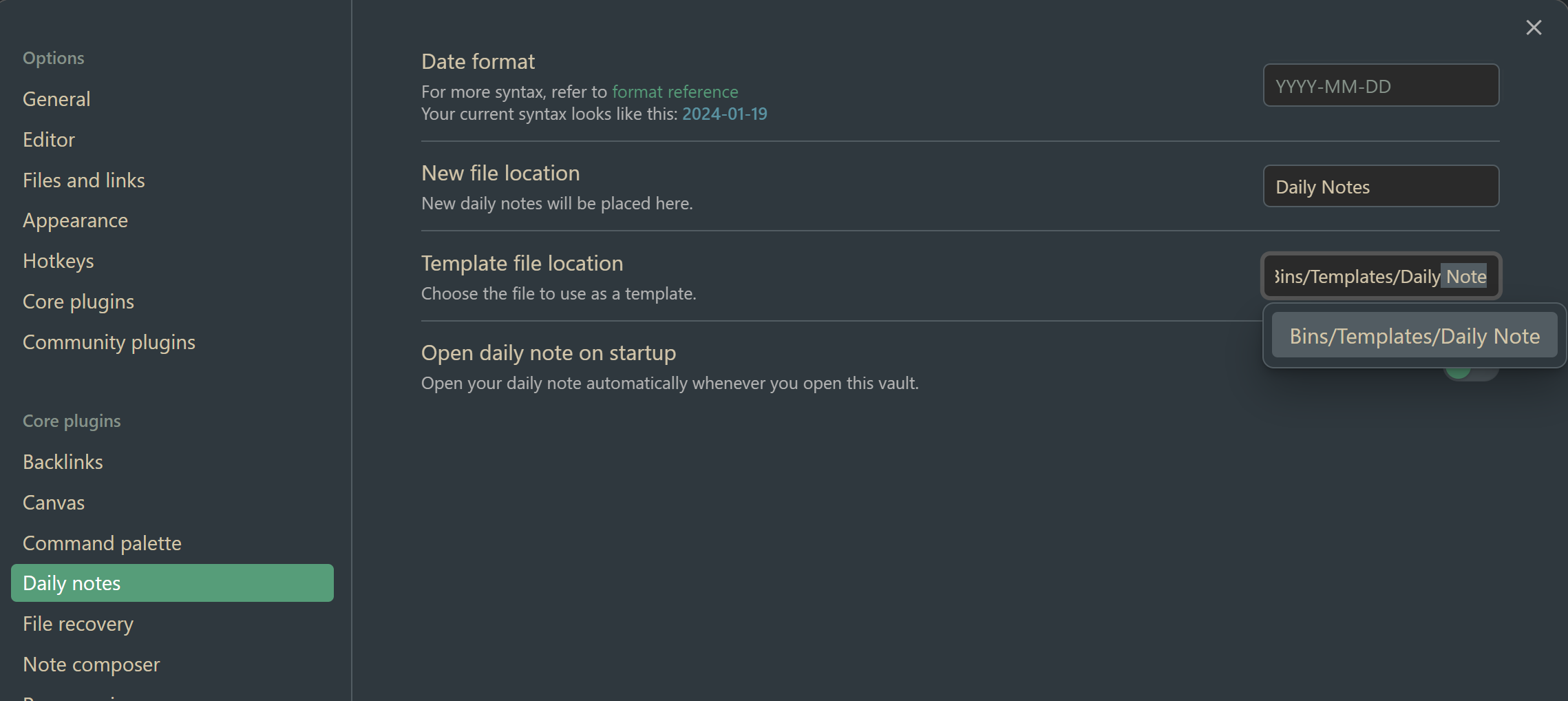
Here’s my config for Periodic Notes (you’ll see I also use weekly and monthly notes, which I link to from my daily note):
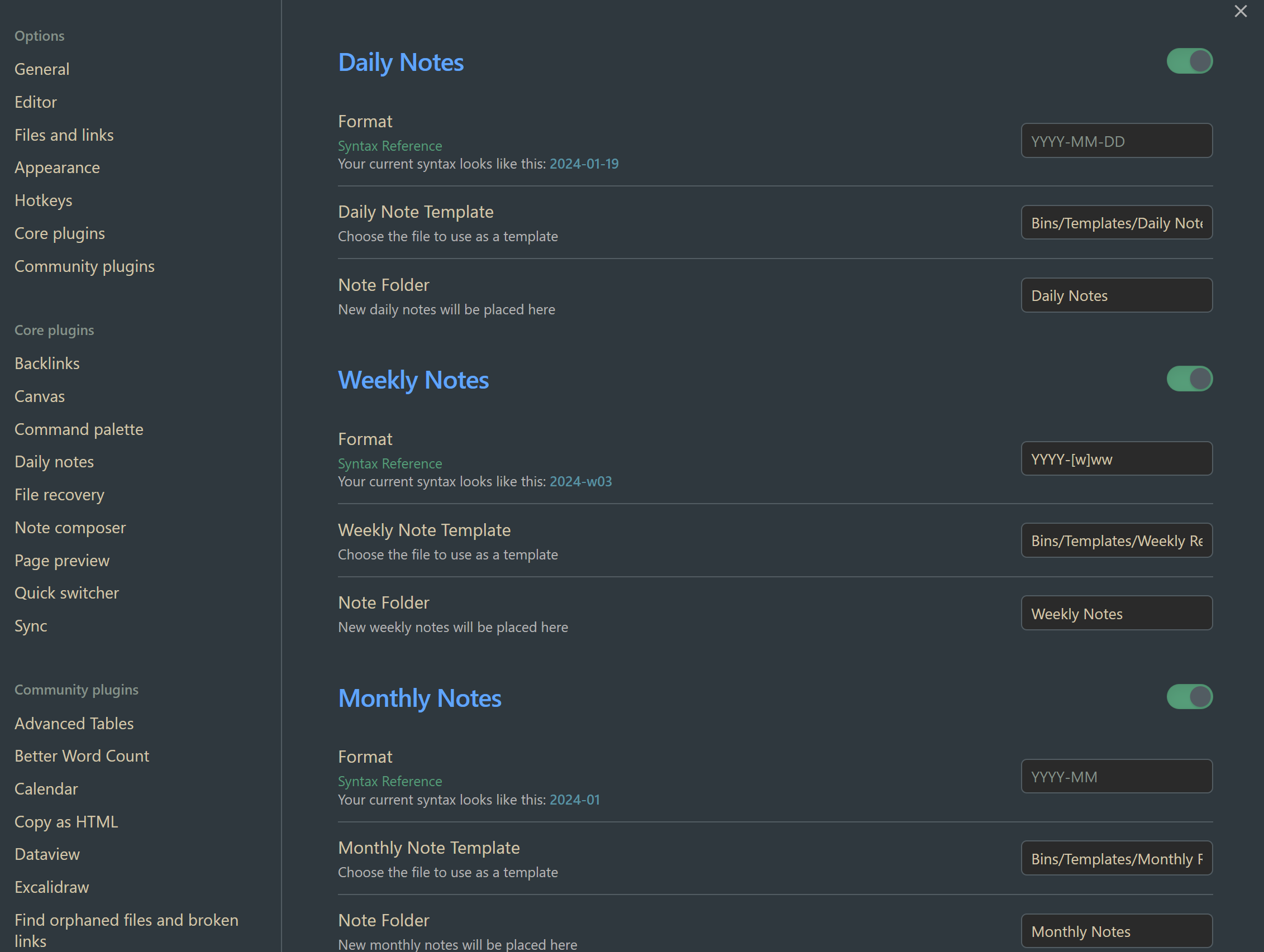
Templater
With Templater, if I create a file from a template, either manually or through Daily Notes or Periodic Notes, I can run some code from my template when the template is instantiated. This allows me to get things like the current date, daily quote, date ranges for tasks, and file title at the time when I use the template.
You can even use Templater to run your own JavaScript during note creation, but I am not using that in the current iteration of my daily notes template.
Here is my current config for Templater:
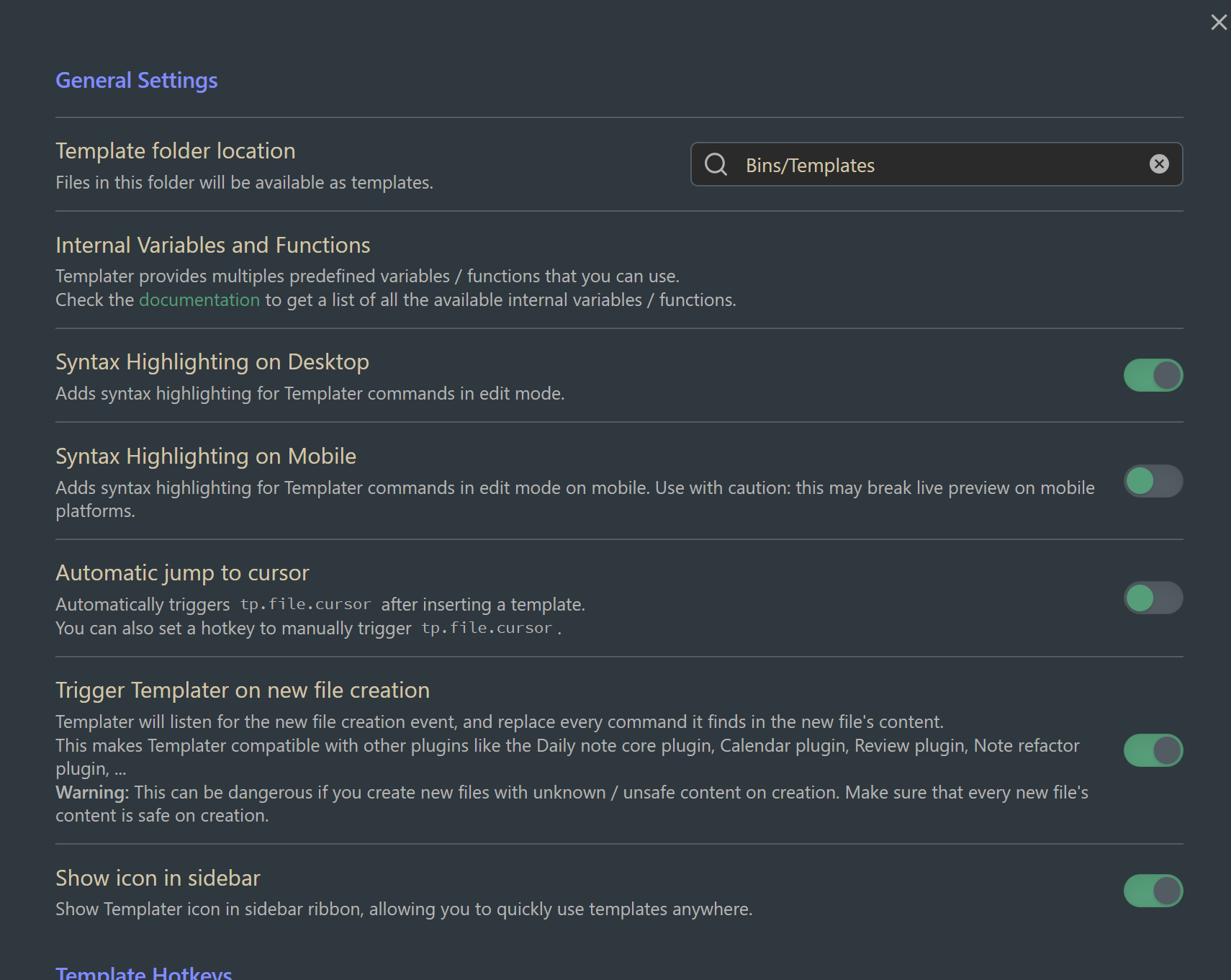
The two important parts are:
I use Templater all over my daily note template, and anything between <% ... %> is Templater syntax.
Dataview
Dataview is a powerful way to query data across all of your notes in your Obsidian vault. For my daily note, I use it to display any notes I created or modified that day.
I don’t believe I did anything unique with the config for Dataview, much of the setup is for viewing preference.
Tasks
Obsidian is the main place I track tasks digitally, and I use the Tasks plugin to do that. My full setup with Tasks warrants a separate post, but for my daily note I use it to capture tasks in my Daily Log and to display tasks that are:
I haven’t changed much from the default Tasks config. I just have it configured to add a “done date” each time I complete a task.
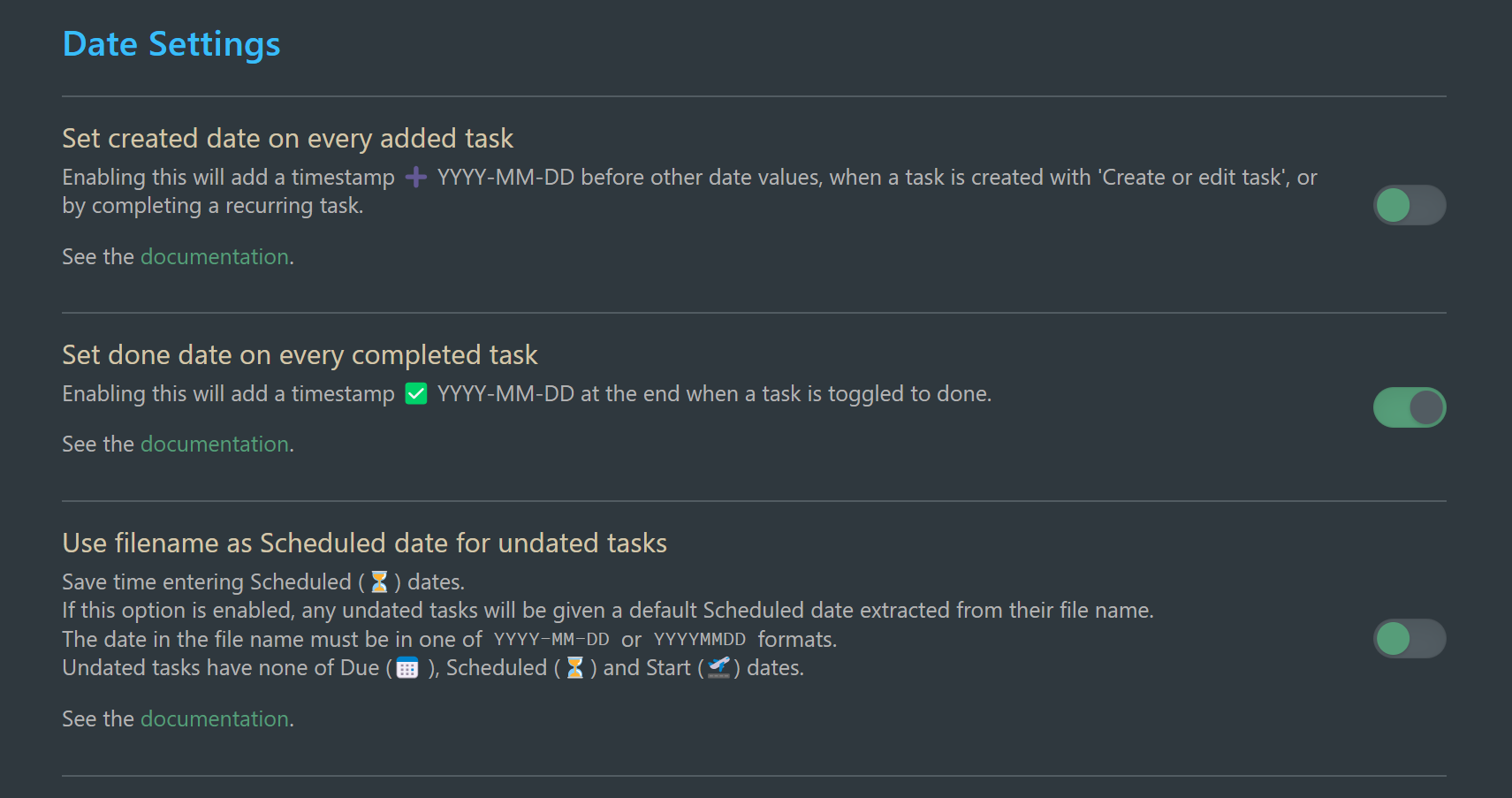
QuickAdd
QuickAdd allows running macros from anywhere in Obsidian. I have a macro setup that can be run from anywhere and allows me to quickly write up text that gets appended at the top of my Daily Log with the current timestamp.
To configure this I created a macro called “Capture to daily note” in QuickAdd:
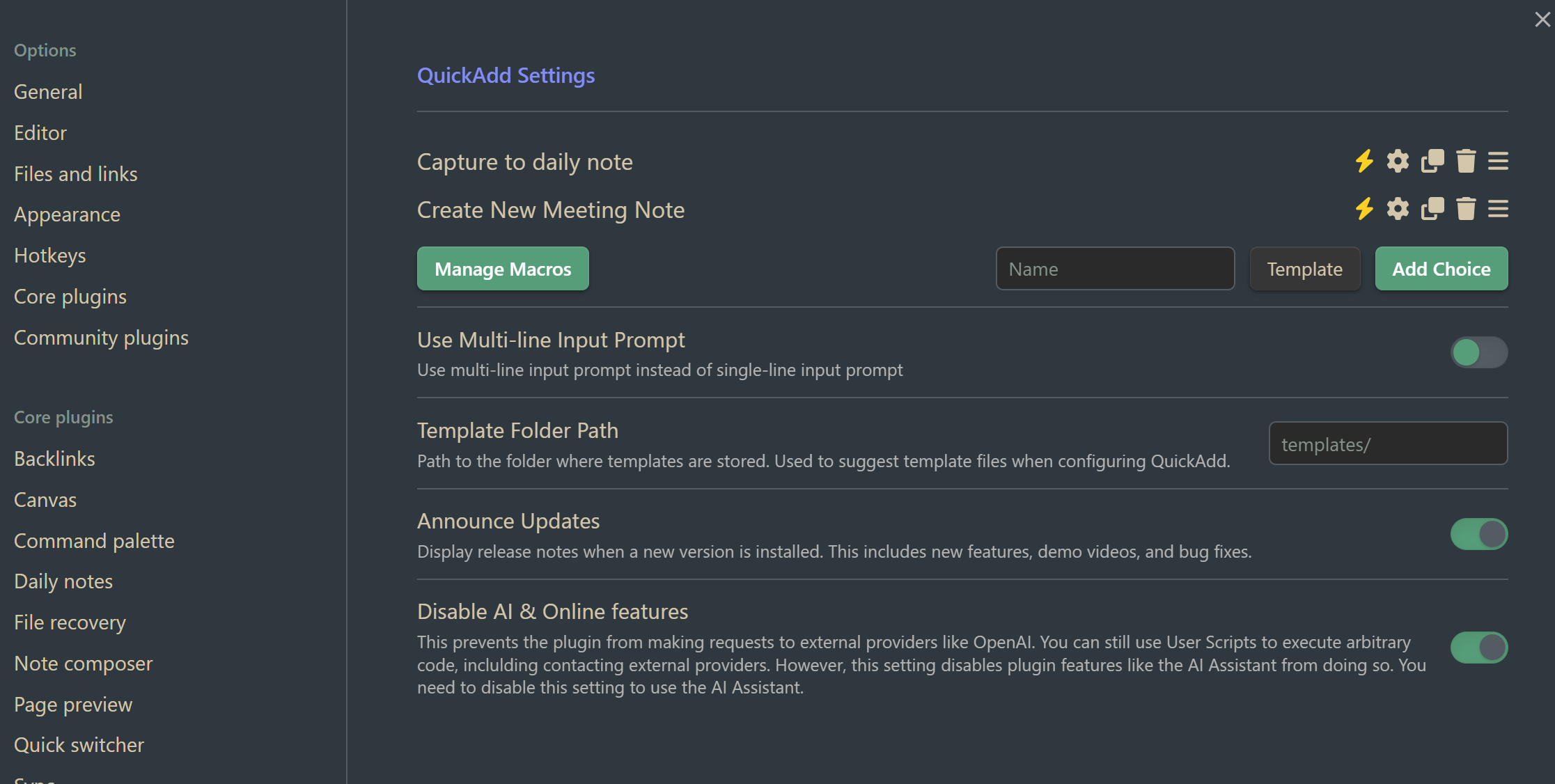
In the settings for that macro, I tell it where to add the text, and how to create the Daily Note if it has not already been created:
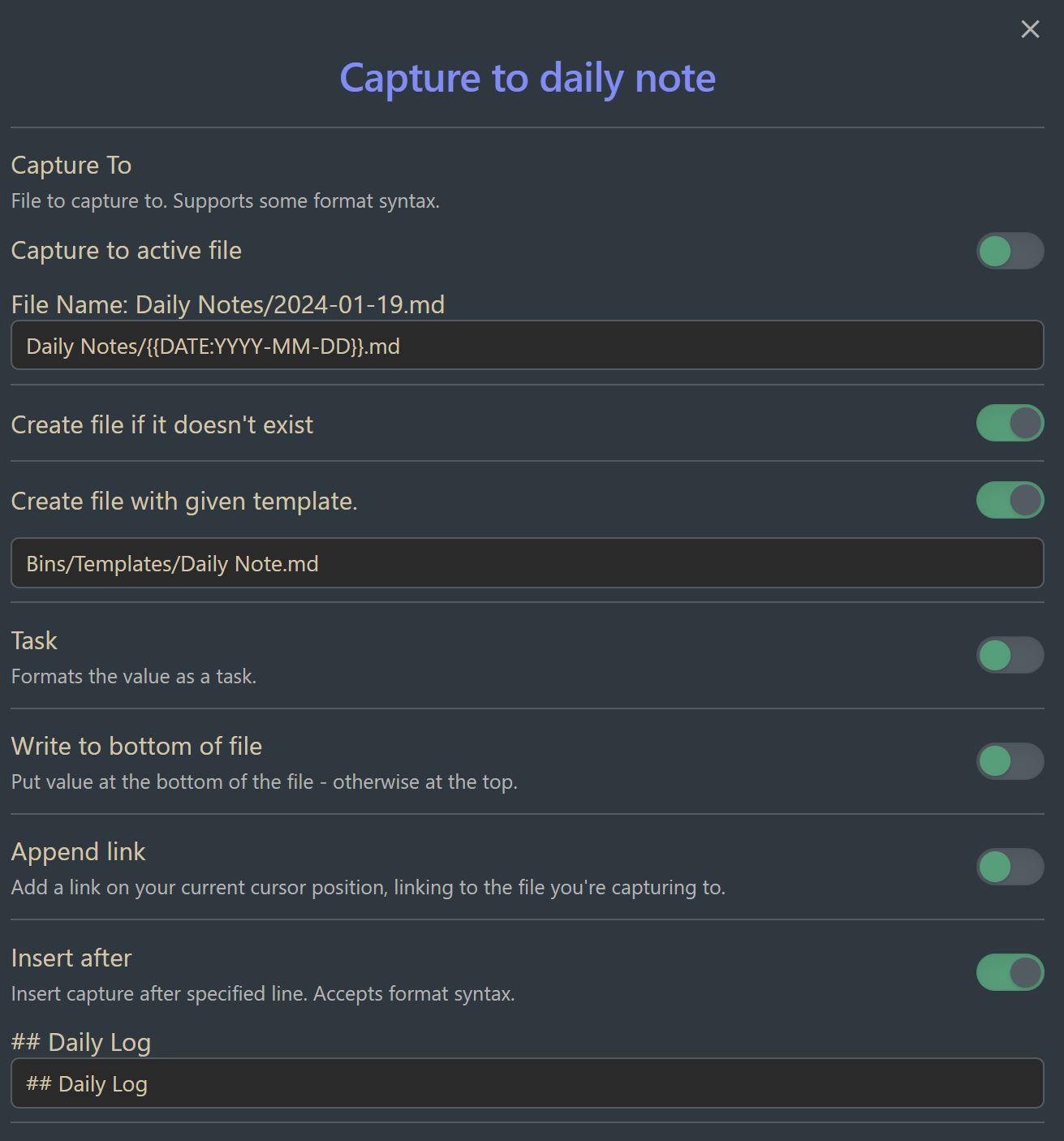
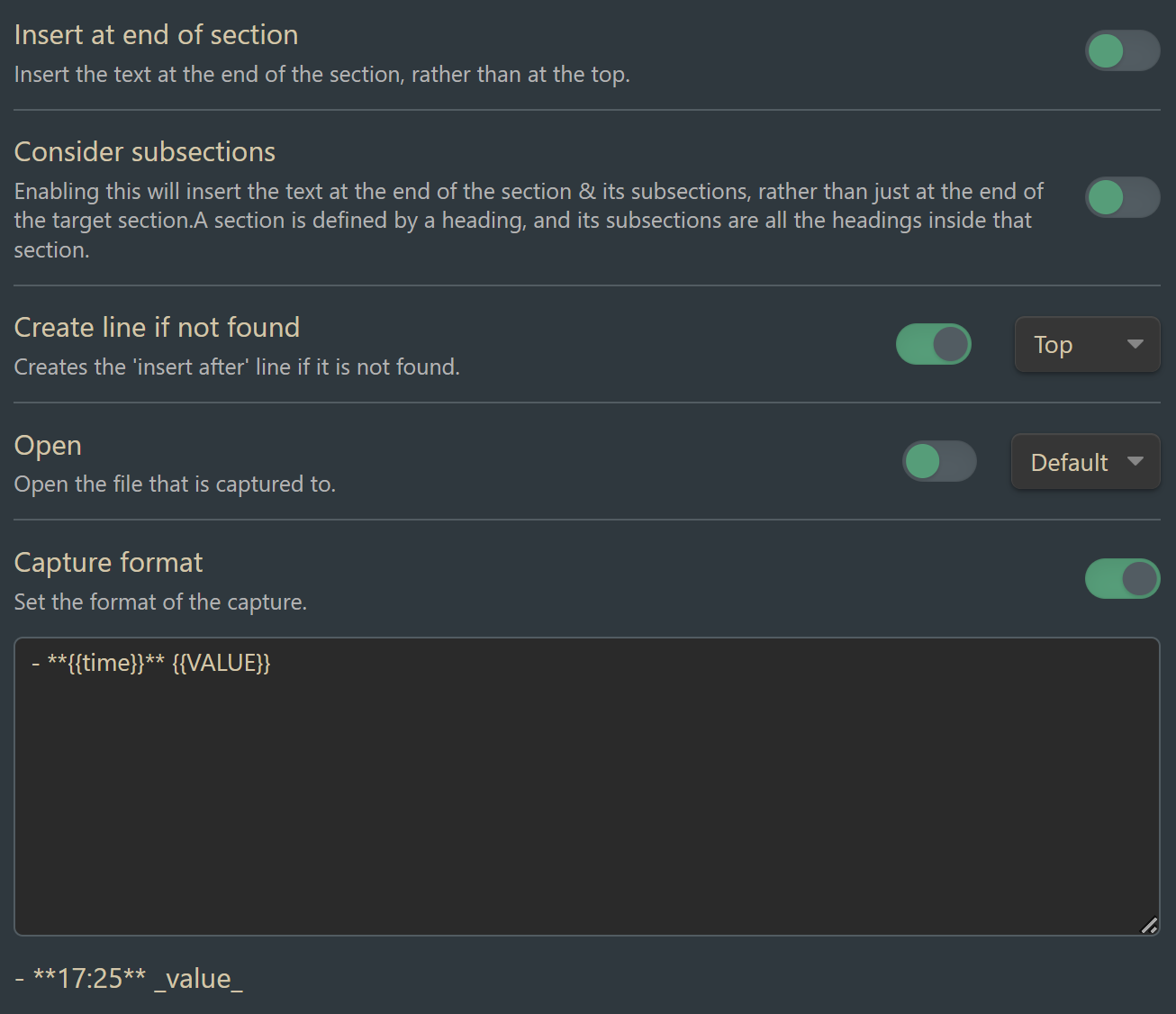
To summarize, QuickAdd looks for today’s daily note, and then inserts my supplied text after the header I supplied, which is ## Daily Log, and gives it some special formatting that I specify near the bottom of the settings. More on this in the Daily Log Section.
Buttons
Buttons allows you to place buttons in your notes that can run macros. I use a button in my daily note templated to run the QuickAdd macro I described above. This allows me to really quickly capture a short note to my daily log, even if I am viewing my Daily Note on reading mode (which is something I end up doing often from mobile).
Calendar
I use the calendar plugin to navigate between my daily and weekly notes, and to create them.
The Template
You can get the full template from this Gist on Github. Below I’ll break down the template by section so you can take only the pieces and parts you need.
Frontmatter Habits
Template
---
week: <% tp.date.now('ww',0, tp.file.title, 'YYYY-MM-DD') %>
weight:
startEating:
endEating:
tags: daily
---
Plugins Used
Description
For my habits section, I use the YAML frontmatter of the markdown file to track any daily habits. I use Templater to get the week number and save it as a property. I also use the Frontmatter to tag all daily notes with the #daily tag. After that, all additional front matter fields are used to track daily metrics, which could be things like weight, times, mood, etc.
To be honest, I don’t use this much anymore, but it was useful when I was doing intermittent fasting. I was eating within an 8 hour window each day, so I used this section to track when I started eating, when I stopped eating, and my weight. Then, with this data stored in each daily note, I used the Obsidian Charts plugin in my weekly and monthly notes to trend my progress over time. If you are interested in how this is setup, shoot me an email and let me know.
Example of Obsidian Charts in one of my monthly notes:
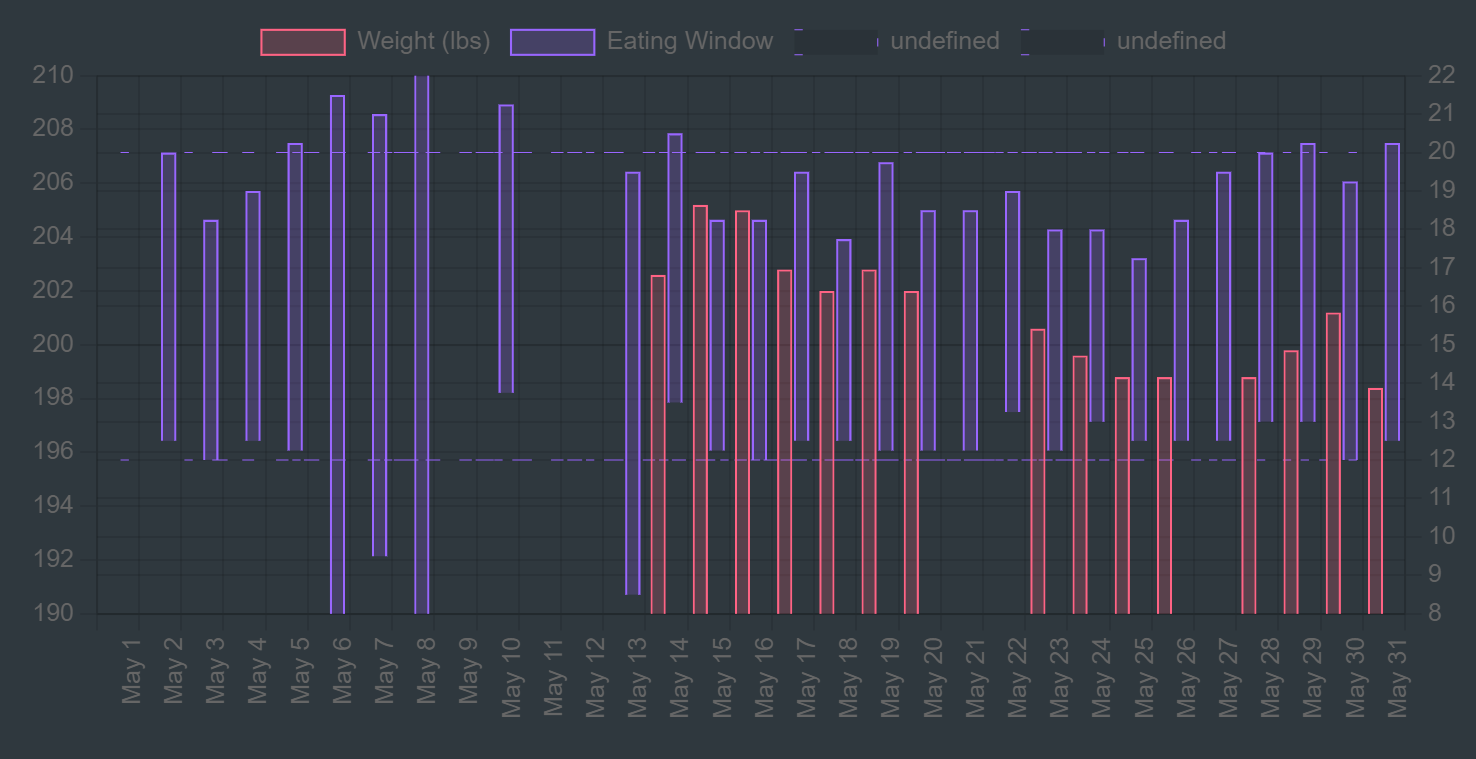
Daily Quote
Template
<% tp.web.daily_quote() %>
Output Example

Plugins Used
Description
I like having a new quote at the top of each of my daily notes. Templater has a built-in function I use that returns the quote of the day when the template is instantiated.
Title
Template
# <% tp.date.now("dddd, MMMM Do YYYY", 0, tp.file.title, "YYYY-MM-DD") %>
Output Example

Plugins Used
Description
All my daily notes have a file title in the format YYYY-MM-DD, but I like having a more readable format that includes the weekday.
I use the tp.date.now function to format the date from the title of the file. Here are what the 4 different parameters in the function do:
Navigation
Template
[[ <% tp.date.now("YYYY-MM-DD", -1, tp.file.title, "YYYY-MM-DD") %> | ⬅️ Yesterday]] | [[<% tp.date.now("YYYY-MM-DD", 1, tp.file.title, "YYYY-MM-DD") %> | ➡️ Tomorrow]] | [[<% tp.date.now("YYYY-[w]WW", 0, tp.file.title, "YYYY-MM-DD") %> | 📖 Weekly]] | [[<% tp.date.now("YYYY-MM", 0, tp.file.title, "YYYY-MM-DD") %> | 📅 Monthly]]
Output Example
Plugins Used
Description
My navigation section consists of 4 links, each generated with Templater’s tp.date.now function to match the title of another “periodic” note in my vault.
The 4 links are:
Yesterday
[[ <% tp.date.now("YYYY-MM-DD", -1, tp.file.title, "YYYY-MM-DD") %> | ⬅️ Yesterday]]
Tomorrow
[[<% tp.date.now("YYYY-MM-DD", 1, tp.file.title, "YYYY-MM-DD") %> | ➡️ Tomorrow]]
Weekly
[[<% tp.date.now("YYYY-[w]WW", 0, tp.file.title, "YYYY-MM-DD") %> | 📖 Weekly]]
Monthly
[[<% tp.date.now("YYYY-MM", 0, tp.file.title, "YYYY-MM-DD") %> | 📅 Monthly]]
Daily Log
Template
```button
name Add to Log
type command
action QuickAdd: Capture to daily note
color default
```
^button-rjgc
## Daily Log
Output Example
Empty state

Adding a log with the button

Example of added log

Plugins Used
Description
I like having a Daily Log section to rapid log tasks, ideas, notes, etc. throughout the day. I added a button to help me do this for two reasons:
I described how I configured the QuickAdd macro above in the QuickAdd Plugin section. Once the QuickAdd macro is configured, I can add the Button to my template and use the command type to call my QuickAdd macro.
I do often add things to my daily note without using the “Add to Log” button. This section is where I create and store my tasks 97% of the time. That way, my task location is the daily note, so I can easily see the date it was created and I get the associated context of everything else stored in my daily note.
Tasks
Template
## [[Tasks Dashboard | Tasks]]
> [!overdue]+ Due before <% tp.file.title %>
> ```tasks
> due before <% tp.date.now("YYYY-MM-DD", 0, tp.file.title, "YYYY-MM-DD") %>
> not done
> hide due date
> hide recurrence rule
> group by function task.tags.map( (tag) => tag.split('/')[1] ? tag.split('/').slice(0, 2).join('/') : '')
> ```
> [!due-today]+ Due <% tp.file.title %>
> ```tasks
> due <% tp.date.now("YYYY-MM-DD", 0, tp.file.title, "YYYY-MM-DD") %>
> not done
> hide due date
> hide recurrence rule
> group by function task.tags.map( (tag) => tag.split('/')[1] ? tag.split('/').slice(0, 2).join('/') : '')
> [!coming-soon]- Due soon after <% tp.file.title %>
> ```tasks
> due after <% tp.date.now("YYYY-MM-DD", 0, tp.file.title, "YYYY-MM-DD") %>
> due before <% tp.date.now("YYYY-MM-DD", 4, tp.file.title, "YYYY-MM-DD") %>
> not done
> hide due date
> hide recurrence rule
> group by due
> group by function task.tags.map( (tag) => tag.split('/')[1] ? tag.split('/').slice(0, 2).join('/') : '')
> ```
> [!success]- Completed <% tp.file.title %>
> ```tasks
> done <% tp.date.now("YYYY-MM-DD", 0, tp.file.title, "YYYY-MM-DD") %>
> short mode
> ```
Output Example
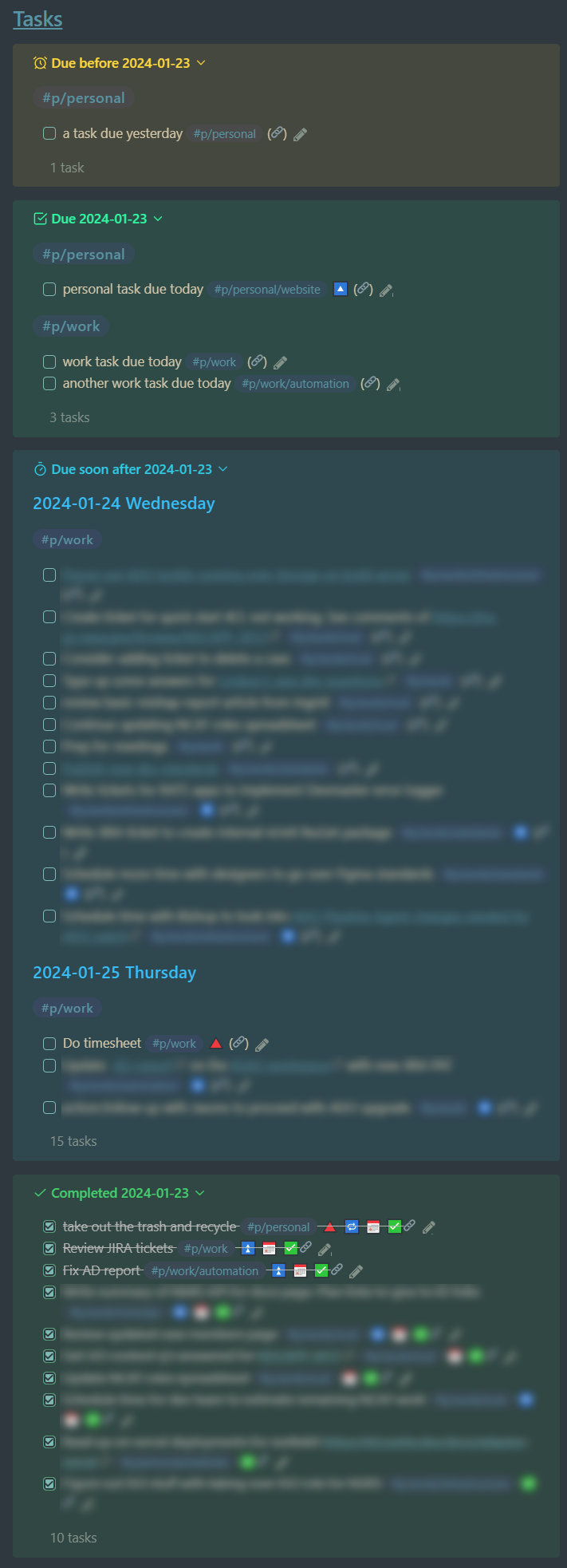
Plugins Used
Description
Setting Up CSS Snippets for Callout Styles
Before I get into the task queries for the template, I’ll mention that I use callouts to contain my task queries because I like the color-coded separation, and I like being able to collapse/expand my task lists. I have set up custom callout styles that I’ve tailored to my task system. The default styles would work fine too, but you can set up custom styles with CSS Snippets.
I followed the docs here to get this set up.
Under “Appearance > CSS Snippets”, click the folder icon to open your snippets folder (.obsidian/snippets).
In this location, create a file called callouts.css that contains the following:
.callout[data-callout="overdue"] {
--callout-color: 255, 215, 0;
--callout-icon: alarm-clock;
}
.callout[data-callout="due-today"] {
--callout-color: 12, 248, 161;
--callout-icon: check-square;
}
.callout[data-callout="coming-soon"] {
--callout-color: 37, 202, 227;
--callout-icon: timer;
}
.callout[data-callout="next-two-weeks"] {
--callout-color: 42, 165, 227;
--callout-icon: hourglass;
}
.callout[data-callout="later"] {
--callout-color: 127, 128, 222;
--callout-icon: calendar;
}
.callout[data-callout="no-date"] {
--callout-color: 163, 80, 250;
--callout-icon: calendar-off;
}
.callout[data-callout="recurring"] {
--callout-color: 216, 191, 216;
--callout-icon: repeat;
}
.callout[data-callout="personal"] {
--callout-color: 240, 240, 240;
--callout-icon: user;
}
.callout[data-callout="work"] {
--callout-color: 240, 240, 240;
--callout-icon: briefcase;
}
Go back to “Appearance > CSS Snippets” and click the refresh icon to reload the snippets into Obsidian’s styles.
Now you can use these callout type identifiers to style your callouts. These are the custom callout types I use to contain different types of tasks. I don’t use all of these in my daily note, some show up in other places like my Tasks Dashboard.
Grouping Tasks
For my daily note, I like my task queries to show tasks in a certain date range (e.g., overdue, due today, due in the next 3 days, completed today) and then within the query, I like to group my tasks by whether they are related to work, personal, or uncategorized. I use tags to assign my tasks to projects, so I look at the tag to determine which group a task should fall into.
My tag structure for organizing tasks has three sections: #{prefix}/{area}/{project}. An example tag would be: #p/personal/website. I prefix all project tags with p/ so that I can quickly pull them all up in the typeahead menu when I start typing a tag. The second part of the tag is the area that the project belongs to, which is either “work” or “personal” in my setup. This is what I like to group my tasks on.
To accomplish this, at the end of my tasks query I have:
group by function task.tags.map( (tag) => tag.split('/')[1] ? tag.split('/').slice(0, 2).join('/') : '')
Here’s what this is doing for each task:
So then my tasks fall into one of 3 groups:
My “due soon” tasks query takes grouping even further, and groups tasks first by their due date and then sub-groups into the areas I defined above.
5 Minute Journal
Template
## 5 Minute Journal
### 🌞
**3 things I am grateful for...**
1.
**What will I do to make today great?**
-
**Daily affirmations**
### 🌚
**What were the highlights from your day?**
1.
**How could I have made today even better?**
Output Example
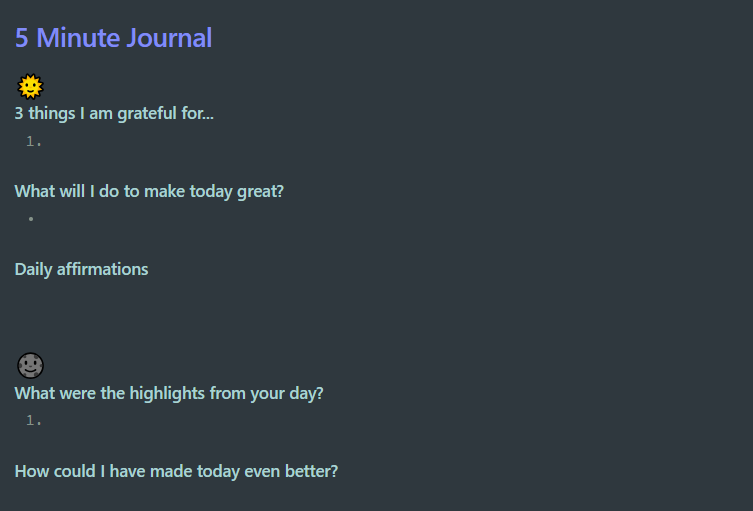
Plugins Used
Description
This section is my quick daily dose of mindfulness when I need it. The first section 🌞 is for the morning, and the second section 🌚 is for the evening.
Today’s Notes
Template
## Today's Notes
> [!example]- Created Today
> ```dataview
> table without id
> file.link as Note,
> file.folder as Folder,
> file.ctime as "Created"
> FROM ""
> where file.ctime >= date(<%tp.file.title%>) AND file.ctime <= date(<%moment(tp.file.title,'YYYY-MM-DD').add(1, 'd').format("YYYY-MM-DD")%>) AND file.path != this.file.path
> sort file.ctime desc
> ```
> [!example]- Modified Today
> ```dataview
> table without id
> file.link as Note,
> file.folder as Folder,
> file.mtime as "Last Modified"
> FROM ""
> where file.mtime >= date(<%tp.file.title%>) AND file.mtime <= date(<%moment(tp.file.title,'YYYY-MM-DD').add(1, 'd').format("YYYY-MM-DD")%>) AND file.path != this.file.path
> sort file.mtime desc
> ```
Output Example
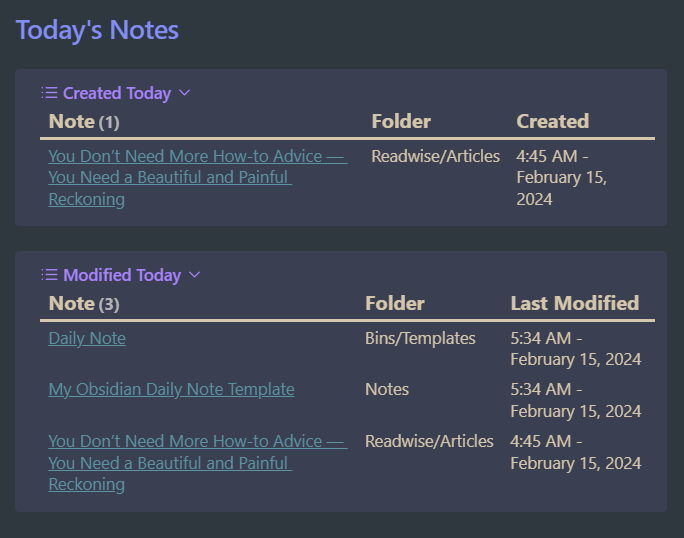
Plugins Used
Description
My “Today’s Notes” section lists any notes I created or modified during the day that the current daily note represents. I like being able to trace this history where I can go back to a daily note and see what I was working on in Obsidian that day.
The logic for Created Today is show files that:
The logic for Modified Today is show files that:
Final Thoughts
I hope this helps you with setting up your own Daily Note template! I took inspiration from many places to put this together, and I hope to give back to the Obsidian community by sharing how I use my Daily Note. It is where I spend at least 80% of my time in Obsidian.
